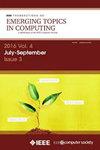Scatter-Gather DMA Performance Analysis Within an SoC-Based Control System for Trapped-Ion Quantum Computing
IF 5.4
2区 计算机科学
Q1 COMPUTER SCIENCE, INFORMATION SYSTEMS
IEEE Transactions on Emerging Topics in Computing
Pub Date : 2025-01-17
DOI:10.1109/TETC.2025.3528899
引用次数: 0
Abstract
Scatter-gather dynamic-memory-access (SG-DMA) is utilized in applications that require high bandwidth and low latency data transfers between memory and peripherals, where data blocks, described using buffer descriptors (BDs), are distributed throughout the memory system. The data transfer organization and requirements of a Trapped-Ion Quantum Computer (TIQC) possess characteristics similar to those targeted by SG-DMA. In particular, the ion qubits in a TIQC are manipulated by applying control sequences consisting primarily of modulated laser pulses. These optical pulses are defined by parameters that are (re)configured by the electrical control system. Variations in the operating environment and equipment make it necessary to create and run a wide range of control sequence permutations, which can be well represented as BD regions distributed across the main memory. In this article, we experimentally evaluate the latency and throughput of SG-DMA on Xilinx radiofrequency SoC (RFSoC) devices under a variety of BD and payload sizes as a means of determining the benefits and limitations of an RFSoC system architecture for TIQC applications.基于soc的捕获离子量子计算控制系统中的散射-聚集DMA性能分析
分散-收集动态内存访问(SG-DMA)用于在内存和外设之间需要高带宽和低延迟数据传输的应用程序,其中使用缓冲区描述符(bd)描述的数据块分布在整个内存系统中。捕获离子量子计算机(TIQC)的数据传输组织和要求与SG-DMA的目标具有相似的特征。特别是,TIQC中的离子量子位是通过应用主要由调制激光脉冲组成的控制序列来操纵的。这些光脉冲由电气控制系统(重新)配置的参数定义。操作环境和设备的变化使得有必要创建和运行范围广泛的控制序列排列,这可以很好地表示为分布在主存储器上的BD区域。在本文中,我们通过实验评估了赛灵思射频SoC (RFSoC)设备在各种BD和有效载荷大小下的SG-DMA延迟和吞吐量,作为确定RFSoC系统架构用于TIQC应用的优点和局限性的一种手段。
本文章由计算机程序翻译,如有差异,请以英文原文为准。
求助全文
约1分钟内获得全文
求助全文
来源期刊

IEEE Transactions on Emerging Topics in Computing
Computer Science-Computer Science (miscellaneous)
CiteScore
12.10
自引率
5.10%
发文量
113
期刊介绍:
IEEE Transactions on Emerging Topics in Computing publishes papers on emerging aspects of computer science, computing technology, and computing applications not currently covered by other IEEE Computer Society Transactions. Some examples of emerging topics in computing include: IT for Green, Synthetic and organic computing structures and systems, Advanced analytics, Social/occupational computing, Location-based/client computer systems, Morphic computer design, Electronic game systems, & Health-care IT.
 求助内容:
求助内容: 应助结果提醒方式:
应助结果提醒方式:


